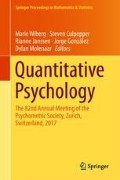Abstract
Differential item functioning (DIF) occurs when individuals from different groups with the same level of ability have different probabilities of answering an item correctly. In this paper, we develop a Bayesian approach to detect DIF based on the credible intervals within the framework of item response theory models. Our method performed well for both uniform and non-uniform DIF conditions in the two-parameter logistic model. The efficacy of the proposed approach is demonstrated through simulation studies and a real data application.
Access this chapter
Tax calculation will be finalised at checkout
Purchases are for personal use only
References
Birnbaum, A. (1968). Some latent trait models and their use in inferring an examinee’s ability. In F. M. Lord & M. R. Novick (Eds.), Statistical theories of mental test scores (pp. 397–479). Reading, MA: Addison-Wesley.
Camilli, G., & Penfield, D. A. (1997). Variance estimation for differential test functioning based ore Mantel-Haenszel statistics. Journal of Educational Measurement, 34, 123–139.
Chang, Y.-W., Tsai, R.-C., & Hsu, N.-J. (2014). A speeded item response model: Leave the harder till later. Psychometrika, 79, 255–274.
Chang, J., Tsai, H., Su, Y.-H., & Lin, E. M. H. (2016). A three-parameter speeded item response model: Estimation and application. In L. A. van der Ark, D. M. Bolt, W.-C. Wang, J. A. Douglas, & M. Wiberg (Eds.), Quantitative psychology research (Vol. 167) (pp. 27–38). Switzerland: Springer.
Dahiru, T. (2008). P-value, a true test of statistical significance? A cautionary note. Annals of Ibadan Postgraduate Medicine, 6, 21–26.
Dancer, L. S., Anderson, A. J., & Derlin, R. L. (1994). Use of log-linear models for assessing differential item functioning in a measure of psychological functioning. Journal of Consulting and Clinical Psychology, 62, 710–717.
de Ayala, R. J. (2009). The theory and practice of item response theory. New York: Guilford Press.
Embretson, S. E., & Reise, S. P. (2000). Item response theory for psychologists. Mahwah, NJ: L. Erlbaum Associates.
Garthwaite, P., Jolliffe, I., & Jones, B. (2002). Statistical inference. Oxford: Oxford University Press.
Glas, C. A. W. (1998). Detection of differential item functioning using Lagrange multiplier tests. Statistica Sinica, 8, 647–667.
Hambleton, R. K., & Rogers, H. J. (1989). Detecting potentially biased test items: Comparison of IRT area and Mantel-Haenszel methods. Applied Measurement in Education, 2, 313–334.
Holland, P. W., & Thayer, D. T. (1988). Differential item functioning and the Mantel-Haenszel procedure. In H. Wainer & H. I. Braun (Eds.), Test validity (pp. 129–145). Hillsdale, NJ: Lawrence Erlbaum.
Kelderman, H. (1989). Item bias detection using loglinear IRT. Psychometrika, 54, 681–697.
Kok, F. G., Mellenbergh, G. J., & van der Flier, H. (1985). Detecting experimentally induced item bias using the iterative logit method. Journal of Educational Measurement, 22, 295–303.
Li, Z. (2015). A power formula for the Mantel-Haenszel test for differential item functioning. Applied Psychological Measurement, 39, 373–388.
Riley, B. B., & Carle, A. C. (2012). Comparison of two Bayesian methods to detect mode effects between paper-based and computerized adaptive assessments: A preliminary monte carlo study. BMC Medical Research Methodology, 12, 124.
Wang, C., & Xu, G. (2015). A mixture hierarchical model for response times and response accuracy. British Journal of Mathematical and Statistical Psychology, 68, 456–477.
Wang, M., & Woods, C. M. (2017). Anchor selection using the Wald test anchor-all-test-all procedure. Applied Psychological Measurement, 41, 17–29.
Wang, W.-C. (2004). Rasch measurement theory and application in education and psychology. Journal of Education and Psychology, 27, 637–694. (in Chinese).
Acknowledgements
The research was supported by Academia Sinica and the Ministry of Science and Technology of the Republic of China under grant number MOST 104-2118-M-001-008-MY2. The authors would like to thank Rianne Janssen, the Co-Editor, Dr. Yu-Wei Chang and Ms. Yi-Jhen Wu for their helpful comments and suggestions.
Author information
Authors and Affiliations
Corresponding author
Editor information
Editors and Affiliations
Rights and permissions
Copyright information
© 2018 Springer International Publishing AG, part of Springer Nature
About this paper
Cite this paper
Su, YH., Chang, J., Tsai, H. (2018). Using Credible Intervals to Detect Differential Item Functioning in IRT Models. In: Wiberg, M., Culpepper, S., Janssen, R., González, J., Molenaar, D. (eds) Quantitative Psychology. IMPS 2017. Springer Proceedings in Mathematics & Statistics, vol 233. Springer, Cham. https://doi.org/10.1007/978-3-319-77249-3_25
Download citation
DOI: https://doi.org/10.1007/978-3-319-77249-3_25
Published:
Publisher Name: Springer, Cham
Print ISBN: 978-3-319-77248-6
Online ISBN: 978-3-319-77249-3
eBook Packages: Mathematics and StatisticsMathematics and Statistics (R0)

